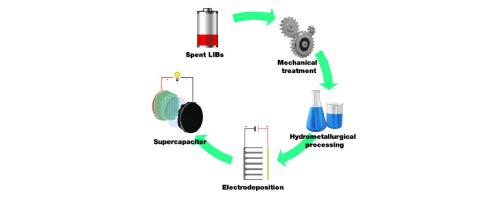Journal of Energy Chemistry ( IF 14.0 ) Pub Date : 2020-11-01 , DOI: 10.1016/j.jechem.2020.10.025 Pier Giorgio Schiavi , Pietro Altimari , Robertino Zanoni , Francesca Pagnanelli

|
A novel process is reported which produces an asymmetric supercapacitor through the complete recycling of end-of-life lithium ion batteries. The electrodic powder recovered by industrial scale mechanical treatment of spent batteries was leached and the dissolved metals were precipitated as mixed metals carbonates. Nanowires battery-type positive electrodes were produced by electrodeposition into nanoporous alumina templates from the electrolytic baths prepared by dissolution of the precipitated carbonates. The impact of the different metals contained in the electrodic powder was evaluated by benchmarking the electrochemical performances of the recovered nanowires-based electrodes against electrodes produced by using high-purity salts. Presence of inactive Cu in the nanowires lowered the final capacitance of the electrodes while Ni showed a synergistic effect with cobalt providing a higher capacitance with respect to synthetic Co electrodes. The carbonaceous solid recovered after leaching was in-depth characterized and tested as negative electrode. Both the chemical and electrochemical characterization indicate that the recovered graphite is characterized by the presence of oxygen functionalities introduced by the leaching treatment. This has led to the obtainment of a recovered graphite characterized by an XPS C/O ratio, Raman spectrum and morphology close to literature reports for reduced graphene oxide. The asymmetric supercapacitor assembled using the recovered nanowires-based positive electrodes and graphite as negative electrodes has shown a specific capacitance of 42 Fg-1, computed including the whole weight of the positive electrode and recovered graphite, providing a maximum energy density of ∼9 Whkg−1 and a power density of 416 Wkg−1 at 2.5 mA cm-2.
中文翻译:

完全回收废旧锂离子电池,并生产核-壳纳米线//片状石墨不对称超级电容器
据报导了一种新方法,该方法通过完全回收寿命终止的锂离子电池来生产不对称的超级电容器。通过工业规模对废电池进行机械处理而回收的静电粉末被浸出,并且溶解的金属作为混合金属碳酸盐沉淀出来。通过将通过沉积沉淀的碳酸盐溶解而制备的电解浴电沉积到纳米多孔氧化铝模板中来生产纳米线电池型正极。通过将回收的基于纳米线的电极相对于使用高纯度盐制得的电极的电化学性能进行基准测试,可以评估包含在电极粉末中的不同金属的影响。纳米线中无活性铜的存在降低了电极的最终电容,而镍显示了协同作用,而钴相对于合成Co电极则提供了更高的电容。对浸出后回收的碳质固体进行了深入表征,并作为负极进行了测试。化学和电化学特征均表明,回收的石墨的特征在于存在通过浸提处理引入的氧官能团。这导致获得了具有XPS C / O比,拉曼光谱和形态学特征的回收石墨,其与还原氧化石墨烯的文献报道相近。使用回收的基于纳米线的正极和石墨作为负极组装而成的不对称超级电容器,其比电容为42 Fg-1包括正电极和回收石墨的总重量,在2.5 mA cm -2时提供的最大能量密度为〜9 Whkg -1,功率密度为416 Wkg -1。











































 京公网安备 11010802027423号
京公网安备 11010802027423号